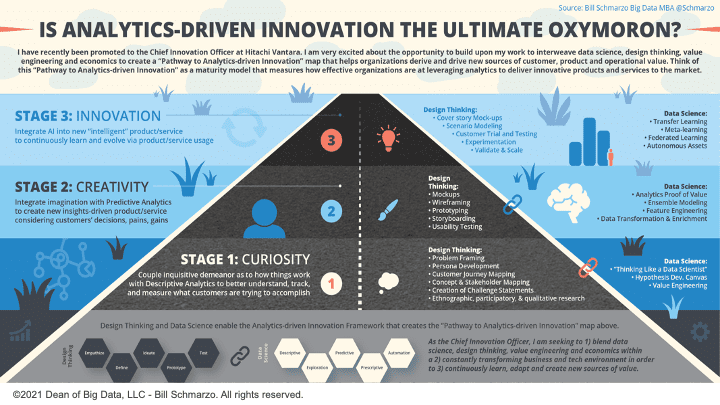
In my first blog of the series “Fallacy of Becoming Data-driven – Part 1: Becoming Value-obsessed”, I preached about the critical importance of reframing the conversion away from data-driven to becoming value-obsessed. Instead of focusing on becoming value-driven, organizations need to focus on how to uncover the customer, product, service, and operational insights buried in their data sets to optimize key business processes, mitigate compliance and regulatory risk, optimize operational excellent, uncover new revenue streams, and create a more compelling, differentiated customer experience!
The motivation for the Part 1 blog was the report from Thomas Davenport and Randy Bean titled “Data and AI Leadership Executive Survey 2022.” The report highlights how achieving a culture of data-driven leadership has stalled (Figure 1).

Figure 1: Fallacy of Becoming a Data-driven Culture
I also shared the six keys (formerly steps, but that didn’t make any sense) in transitioning from data-driven to value-obsessed. However, these six steps are insufficient in your value-obsessed journey. Embrace only these six keys, and you probably won’t see any major uptick in the success of your organization’s value-obsessed journey. To successfully navigate beyond data-driven to value-obsessed, we need key #7 – Create a Culture of Individually Empowered, Analytics-fueled Innovation (Figure 2).

Figure 2: Seven (7) Keys to Becoming Value-obsessed
In this blog I will discuss that key #7 and the critical importance of focusing on cultural transformation and employee empowerment to navigate successfully from data-driven to value-obsessed!
Key 7: Critical Importance of Cultural Transformation
Maybe the industry stall concerning becoming data-driven starts by how we define the end goal of Digital Transformation. I define Digital Transformation as such:
Digital Transformation is about creating a culture and business model of continuous learning, adapting, and refining – both AI‐driven and human‐empowered – that seeks to identify, codify, and operationalize individualized customer, product, and operational insights (predicted behavioral and performance propensities) to reinvent their business processes and transform their business models.
Digital Transformation is about Cultural Transformation and creating a company culture of empowered employees who can continuously explore, try, fail, and learn in a world of continuously learning, adapting, and refining AI/ML-enabled digital assets (see the blog “Creating Assets that Appreciate, Not Depreciate, in Value Thru Continuous Learning” for how to leverage AI/ML to create continuously-learning, adapting, and refining digital assets).
Cultural Transformation is about embracing natural conflicts to unleash the curiosity, creativity, and ideation of everyone in the organization to fuel innovation to solve today’s wickedly hard problems.
The key part of cultural transformation is realizing that conflict is natural and can be the source for game-changing innovation.
Cultural Transformation = Moving Beyond Optimization to Re-invention.
If you had challenged car manufacturers in 1979 to increase automobile horsepower (HP) while also increasing mileage per gallon (MPG), auto executives would have looked at you like you had lobsters crawling out of your ears. However, that is exactly what happened.
The U.S. Government-mandated higher fuel mileage in 1975 and again in 2007. And instead of going out of business, car manufacturers embraced the conflict and increased both MPG and HP through product design, development, experimentation, and manufacturing innovations (Figure 3).

Figure 3: Embracing Conflict to Fuel Innovation
This innovative transition requires a culture of abundance and sharing – to democratize ideation – where diverse perspectives and experiences are blended, bent, meshed, and synergized across individual assets and perspectives. Compromising on the “Least Worst” option wasn’t going to address the auto industry’s challenge (Figure 4).

Figure 4: From “Least Worst” to “Best Best”
As discussed in “Decisions Part 2: Creating a Culture of Analytics-driven Innovation”, Digital Transformation must move organizations beyond optimizing the organization’s existing business processes. What if those business processes are outdated and no longer relevant? Digital Transformation must do more than just “optimize the cow path”.
Cultural Transformation has the potential to go beyond just optimizing to re-invent business processes and transform business models. But that requires empowering the entire organization. That requires empowering organizational improvisation (improv).
Cultural Transformation = Empowering Organizational Improv
The BusinessWeek article “Steal These Art World Techniques to Improvise in the C-Suite” talks about the power of the “Yes, and…” mentality to unleash the innovative power of improvisation with senior leadership.
Improvisation is the ability to compose or invent something new on the spot (in the moment) fueled by a curious exploration and creative departure from preformed plans or expectations.
However, to be successful, it can’t just be senior leadership that is given the privilege to improvise. The best uses of improv to create innovative solutions will happen at the front of customer engagement and operational execution, not the mahogany row of executives who are many layers away from the frontline experience (just telling it as I see it).

Like a great soccer team or jazz quartet, successful organizations embrace Organizational Improv. Organizational Improvisation (impro) yields flexible and malleable teams that can maintain operational integrity while morphing the team’s structure and execution in response to the changing needs of the situation.
Cultural Transformation = Nurturing Curiosity to Unleash Innovation
The “Pathway to Analytics-driven Innovation” blends the disciplines of data science, design thinking, value engineering, and economics to create, capture and deliver new sources of customer, product, service, and operational value fueled by:
- Curiosity – the natural human desire to know or learn something, fostered by an inquisitive demeanor or behavior. It is eager to “take things apart” to see how things work.
- Creativity – the use of imagination, ideation, and ingenuity to create (create is a foundational word in creativity) something that uniquely and more effectively solves a problem.
- Innovation – the ability to blend new concepts, techniques, and/or technologies to scale a challenging operational solution or enhance a customer experience.
Analytics-driven innovation means integrating AI/ML with new data sources to create a new “intelligent” product, process, or service that can continuously learn and evolve (Figure 5).

Figure 5: “Is Analytics-driven Innovation the Ultimate Oxymoron?”
Summary: Critical Role of Cultural Transformation in Becoming Value-obsessed
Digital transformation creates a culture and business model of AI-driven and human-empowered continuous learning, adapting, and refining. Cultural Transformation is required if we exploit the human side of continuous learning, adapting, and refinement.
I love this marvelous quote about the nature of Cultural Transformation from Colin Powell:

Learning through failure is the heart of cultural transformation. That means preparing your organization for the reality that much learning is accomplished through failure. But if your organization is not prepared for failure, then you’ll miss those valuable learning and growth opportunities.
So, do you want to transition your organization from data-driven to value-obsessed? Then empower cultural transformation by blending the empirical nature of the data science with the empowered ideation, failure-based-learning of design thinking. That’s how you cross over the data-driven chasm to creating a value-obsessed culture.
